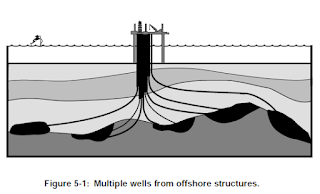Multiple wells from offshore structures
The most common application of directional drilling techniques is in
offshore drilling. Many oil and gas deposits are situated well beyond the
reach of land based rigs. Drilling a large number of vertical wells from
individual platforms is both impractical and uneconomical. The obvious
approach for a large oilfield is to install a fixed platform on the seabed,
from which many directional boreholes can be drilled. The bottomhole
locations of these wells are carefully spaced for optimum recovery.

In conventional development, wells cannot be drilled until the platform has
been constructed and installed. This can mean a delay of several years
before production begins. Such delay scan be considerably reduced by predrilling
some of the wells through a subsea template while the platform is
being constructed. These wells are directionally drilled from a semisubmersible
rig and tied back to the platform once it has been installed.
The most common application of directional drilling techniques is in
offshore drilling. Many oil and gas deposits are situated well beyond the
reach of land based rigs. Drilling a large number of vertical wells from
individual platforms is both impractical and uneconomical. The obvious
approach for a large oilfield is to install a fixed platform on the seabed,
from which many directional boreholes can be drilled. The bottomhole
locations of these wells are carefully spaced for optimum recovery.

In conventional development, wells cannot be drilled until the platform has
been constructed and installed. This can mean a delay of several years
before production begins. Such delay scan be considerably reduced by predrilling
some of the wells through a subsea template while the platform is
being constructed. These wells are directionally drilled from a semisubmersible
rig and tied back to the platform once it has been installed.




